617 Search Results for tell me about it
October 12, 2017
by Carole Zangari -
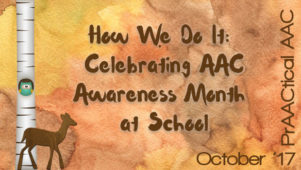
What better way to start the day than to see how AAC Awareness Month is being celebrated in a school system?! Today, pediatric SLP Elisa Parker tells us how they do it in the school district where she works. For the past 20 years, Elisa has served young children in the Park Hill School District in Kansas City, Missouri. Her passion for AAC and children with autism led to her becoming an Autism Coach and Assistive Technology Facilitator. She has been an Autism Coach for the Gerner Family Early Education Center for 7 years and the Assistive Technology Facilitator for 3 years. Elisa consults with and provides AAC training for teachers and support staff of young students who use AAC and has also coached teams at the K-12 level. ============================ Celebrating October – AAC Awareness Month There are so many hardworking staff members I work with who implement AAC in their classrooms... [Read More...]
September 18, 2017
by Carole Zangari -
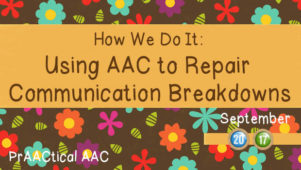
We’ve had many nice comments about the resources shared by AAC SLP Alicia Garcia, clinical lead of the AAC Clinic at One Kids Place, a children’s treatment centre in northern Ontario. With over two decades of experience in pediatric rehabilitation practice in private and public settings, Alicia’s ideas for how to support AAC learners and their families are tried and true. In today’s post, Alicia shares thoughts and materials for situations in which the AAC is needed to repair communication breakdowns. :::::::::::::::::::::::::::::::::::::::::::::::::::::::::::::::::::::::::::::::::::::::::::::::: Children with unclear speech not only have different intelligibility levels but also different levels of awareness, focus, and interest on repairing their communication breakdowns. We use different approaches based on how they react and respond when they are not understood. As a general guideline when a communication breakdown occurs, regardless of the child’s profile, we first try determining the level of urgency or importance of the child’s intended... [Read More...]
September 3, 2017
by Carole Zangari -
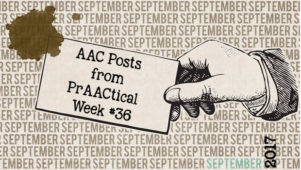
And just like that, it’s ‘Goodbye, Summer’ and ‘Hello Fall.’ It’s been a busy time preparing for the transition, and you may have missed some posts from last week. Here’s what was shared: Monday – PrAACtically September: AAC Resources for a Year of Core Vocabulary Wednesday – Video of the Week: Keep It Fun, Flexible, & Available. AAC All Day Long in the Special Needs Classroom Thursday – PrAACtical Resources on Language Development :::::::::::::::::::::::::::::::::::::::::::::::::::::::::::::::::::::::::::: Not enough reading material to browse? Here are some posts on AAC in the Classroom that may be of interest. AAC in the High School Classroom: Where Core Vocabulary Meets Life Skills TELL ME: AAC in the Preschool Classroom How We Do It: AAC in the Special Education Classroom AAC in the Classroom for Students with Significant Disabilities – Implementation & Data Collection 5 Visual Supports for the AAC Classroom
August 21, 2017
by Carole Zangari -

If you’ve been working in this field for awhile, chances are you’ve got some older voice output technology lying around. Poke around in the back of a closet or tucked way on top of the cupboards and you might encounter some hidden treasures. If you look w-a-a-a-y back there, you just might find a few digitized (recorded) speech devices that haven’t been used for some time. With only 2, 4, 8, 9, or 32 locations, these are generally insufficient for individuals with complex communication needs to use as their personal communication devices. When matched to the right purpose, though, these are wonderful tools that often have a lot of life left in them. How can we put those low tech AAC devices to work? Here are a few ideas to get us started. Build letter-sound knowledge: Program each cell with the sound of each letter so that the AAC student... [Read More...]
August 18, 2017
by Carole Zangari -
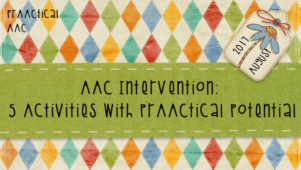
Across the world, therapists, teachers, and parents are getting ready for AAC lessons or therapy sessions. Robust AAC systems? Check! Goals that matter? Check! Effective intervention strategies? Check! Let’s put them all together with some engaging activities that won’t break the bank in terms of materials. Here are some suggestions for tried-and-true activities. Language Experience Surveys: Looking for a fun activity that gives your AAC learner an opportunity to prAACtical his/her skills with a variety of communication partners? Language experience surveys are a great tool for that not just because they are a great way to build generalization in a way that kids really love, but also because it helps the communication partners have supported conversations with AAC users. This helps them get comfortable in interacting with our AAC learners which, in turn, increases the chances that they will want to interact with these students in the future. This is... [Read More...]
June 19, 2017
by Carole Zangari -
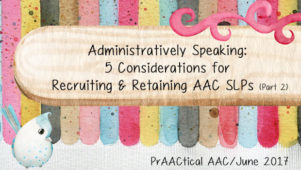
Do any of these situations sound familiar? Janelle, an SLP in an urban elementary school, was flustered when the principal directed her to ensure that her students’ AAC devices didn’t go home on weekends or during school breaks. She hated to see the students lose access to communication during those times but, Janelle understood the principal’s logic. The device had been bought and paid for by the school, and they had to scrounge around to find the funding for it. If it were to get damaged or lost, the school would have to replace it, and there were no funds for that. It was unfortunate, Janelle felt, but, what could she do? Later in the year, when the results of a system-wide audit came out, Janelle’s students were some of the ones identified as having been denied their rights to a Free, Appropriate Public Education (FAPE). Had she known the... [Read More...]
June 7, 2017
by Carole Zangari -
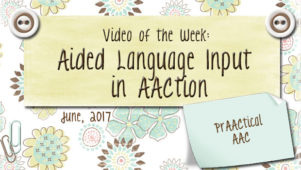
Do you know students like these? In therapy sessions, Victor uses single words on his SGD to participate in games and activities, but doesn’t use it much during other daily experiences. Bella uses PECS quite capably at mealtimes but rarely uses it at other times during the day. Karina can use her AAC app to put together short narratives to tell about things that happened recently. Most times, though, she expresses herself with single word utterances. As therapists, teachers, and families who support people who use AAC, we do a lot of hand wringing when there is a discrepancy between what students KNOW HOW to do and what they DO do. We are perplexed and frustrated when these students have everything they need to utilize a particular skill, yet fail to do so. It’s a common concern, but here’s a question for us to ask ourselves: Don’t we do the... [Read More...]
May 31, 2017
by Carole Zangari -
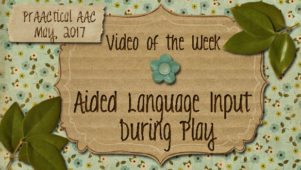
Typically developing children acquire language not through direct instruction but by immersion in an environment where the language of the community is modeled all day long. When they eat and when they play, in care routines at home and in exchanges in the community, children are continually hearing the language they are learning to produce. When parents of Deaf or hard of hearing babies learn of their children’s disability, many clamor to learn sign language and use it as they bathe, feed, and play with their children. These parents may not be perfect sign language models, but they understand that their efforts to learn and use sign language will play a critical role in helping their children learn to communicate effectively. Thus, they strive to sign all day long as they talk to their kids. The pervasive, contextually-driven exposure to language is the foundation on which children build skills in... [Read More...]
May 18, 2017
by Carole Zangari -
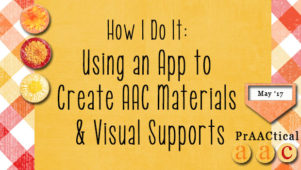
When we think of AAC apps, expressive communication and voice output generally come to mind. But there are other kinds of AAC apps, too, including those that are used to create printable materials. Today, we hear from a clinician who uses this kind of AAC app on a regular basis. Georgia Karavias is a speech language pathologist whose career has centered around working with school-aged children and adolescents who have physical disabilities and communication difficulties. Georgia is passionate about utilizing alternative access methods and inclusive technologies to enable independent communication using AAC systems. She currently works at Scope’s Communication and Inclusion Resource Centre (CIRC) as part of the communication access team in a community capacity building role. In this post, she talks about how she uses AAC and visual supports created with an app developed at her workplace. :::::::::::::::::::::::::::::::::::::::::::::::::::::::::::::::::::::::::::::::::::::::::::::::::::::::: I am a speech pathologist who has worked with children with complex... [Read More...]
May 15, 2017
by Carole Zangari -
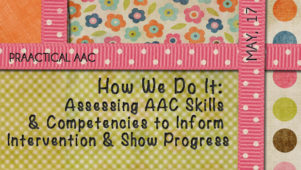
It’s Better Hearing and Speech Month ( #BHSM) and we are highlighting the work of talented AAC SLPs. We’re so happy to have Georgia-based Vicki Clarke back, this time with Holly Schneider, to talk about a longstanding collaboration that more AAC teams need to know about. Vicki’s private practice, Dynamic Therapy Associates, centers on AAC assessment and intervention. She works both with individuals and school districts, and serves children and adults with a variety of challenges and etiologies (e.g., motor disorders, memory, attention and learning difficulties, sensory impairment, neurological differences, syndromes and seizure disorders, congenital and acquired difficulties).Holly is a full time employee of Tobii Dynavox on the Clinical Content and Training Team. She is responsible for developing AAC training materials; and educating teams, professionals and families on AAC applications and implementation. In this post, they tell us about the development of the second edition of the Dynamic AAC Goals Grid.... [Read More...]









